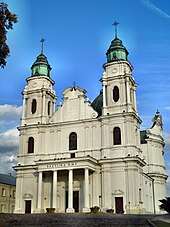Basilica of the Nativity of the Virgin Mary (Chełm)
The Basilica of the Nativity of the Virgin Mary ( Polish Bazylika Narodzenia Najświętszej Maryi Panny ) is a Roman Catholic church in Chełm in the Lublin Voivodeship , Poland . The parish church of the Archdiocese of Lublin with the patronage of the Nativity of Mary was built as a uniate cathedral and was also used by the Orthodox Church. The late Baroque church was built in the mid-eighteenth century, it bears the title of a minor basilica and is a listed building.
history
Originally there was an Orthodox church of the same name on the site of today's basilica, the founder of which was the Rus King Daniel Romanovich of Galicia around 1260 . After the Orthodox Bishop of Chełm Dionizy Zbirujski signed the law of the Brest Union in 1596 and converted to Eastern Catholicism together with the entire diocese, the church became a United Cathedral of the Diocese of Chełm . In the years 1638–1640 it was rebuilt on the initiative of Bishop Methodius Terlecki after the damage caused by fire.
In 1711, Bishop Józef Lewicki (1710–1730) renovated the building and added a transept. As the work was carried out negligently, the building soon collapsed. Therefore, Bishop Felicjan Wołodkowicz (1731–1756) ordered the demolition of the building and the construction of a larger church, the demolition took place in 1735, the construction work lasted until 1756. The last phase of the construction work was led by Bishop Maksymilian Ryłło (1756–1784). The interior design was done by the Lviv artist Michał Filewicz. The cathedral was built according to the design by Paweł Fontana under the supervision of the architect Tomasz Rezler. It received the style of Western European Baroque, similar to the Roman Catholic churches. Inside, the features of the Greek rite were lost, a choir, confessionals, a high altar and five side altars were created.
In 1802 the church burned down. In 1805 the bishopric was moved to Lubmin. In 1809 and in the years 1827 to 1839, thanks to Bishop Ferdynand Dąbrowa-Ciechanowski, it was rebuilt to give its exterior façades classical forms. The funds came from the treasury of the Kingdom of Poland.
After the union was dissolved in 1875, it was converted into an Orthodox cathedral and rebuilt in the Byzantine-Russian style in 1874–1878. The towers were complemented with onion-shaped helmets, and the gables were given the style of Moorish arches. At that time, a four-column portico was built in front of the main entrance , which has been preserved to this day.
When the Austrian army marched into Chełm in 1915, an arms and ammunition store was set up in the building and was used until November 2, 1918. In May 1919 the building was taken over by the Roman Catholic Church. Then the cathedral was taken over by the Jesuits. They also tried after 1931 to return it to appear before 1875.
In 1935 the building went to diocesan priests, after which a new parish was founded. In 1938 a thorough renovation of the building was completed, led by Konrad Szretter and J. Siennicki. They left a classical portico, but instead of a tympanum there was a gallery with a balustrade. They also added motifs from churches associated with Tomasz Rezler , who at the time was mistakenly considered the designer of the church. There were also plans to change the interior of the church. In 1935, the National Cultural Fund announced a painting competition which the painter Felicjan Szczęsny Kowarski won. The plans were not implemented due to a lack of financial resources. In May 1940, the cathedral was handed over to the Orthodox Ukrainians by the German occupation authorities, which was in connection with the campaign to Ukrainize the Chełm country. In November 1940 the church became the seat of the bishop of the Chełm-Podlasie diocese. On August 24, 1944, the church was handed over to the Catholics and the function of a Roman Catholic parish church was restored. Pope John Paul II granted the church the rank of minor basilica in 1988. The basilica is the seat of the Chełm Collegiate Chapter.
architecture
The three-nave church has a Latin cross plan , a transept and two towers (decorated with corner pillars and covered with helmets) in the facade, and the dome ended with a lantern. Crosses with crescent moons crowning the helmets of the towers were placed on sceptres with spheres. The building has three entrances with gable portals. Under the choir and the transept are the graves of the Greek Catholic bishops of Chełm. The original church furnishings have not been preserved. In the main altar is a replica of the miraculous painting of Our Lady of Chełms from 1938, the original of which is now in the Museum of the Volhynian Icon in Lutsk .
There is also a late Baroque antependium from 1720–1750 with a scene of homage to Our Lady of Chełm after the Battle of Berestechko in 1651 by King John II Casimir and two paintings from the end of the 18th century by Franciszek Smuglewicz : Crucifixion and St. Onophrios .
literature
- Piotr Krasny: Katedra unicka w Chełmie: O problemach badań nad architekturą sakralną kościoła greckokatolickiego w XVIII wieku , Sztuka Kresów Wschodnich: materiały sesji naukowej , p. 3, 1998.
Web links
Individual evidence
- ↑ Bazylika Narodzenia NMP on gcatholic.org
Coordinates: 51 ° 7 ′ 53.3 " N , 23 ° 28 ′ 49.7" E


